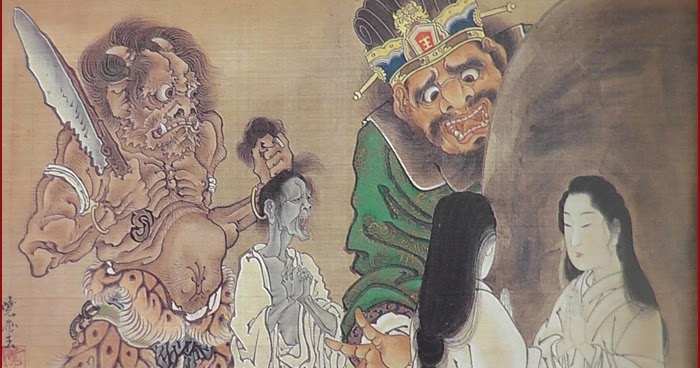Japan
Japanese civilization is probably one of the most controversial in terms of modernity. This is a world of contrasts – traditions and progress.
In Japan, the most widespread religion is Shintoism (literally – “the way of the gods”).
Shinto is the national religion of Japan. It originated from the beliefs of the ancient Japanese that there are two worlds – the real and the other world.
Each of the worlds is inhabited by living beings. The real world is inhabited by people, and spirits rule in the afterlife.
To get to the world of the dead, you first need to cross the desert plain and mountains, cross the Sanzu River (the border between the world of the living and the dead).
According to beliefs, usually people cross the river on the seventh day after death.
There are three ways to cross the river: across the bridge, through the ford, and through the dragon-infested waters.
How a person will cross the river depends on the deeds committed during his lifetime.
The pure in soul cross the river over a bridge adorned with treasures. People who have done both good and bad deeds in equal measure ford the river.
Those who during their lifetime did only bad deeds will have to swim across the river, teeming with terrible dragons and monsters that will prevent them from crossing the river.

The souls of the dead are melted across the river
After that, an old man and an old woman are waiting on the other side.
The old woman is called Datsue-ba, she takes off clothes from the dead, and an old man named Keneo hangs them on a tree branch to determine the severity of misconduct. Then people are sent to the court to the Great King Emma.
Emma is the god of the underworld, who decides the fate of all creatures after their death.
He is depicted as a large man with a red face, bulging eyes and a beard. He wears a traditional Japanese attire and wears a crown on his head, which depicts a hieroglyph that translates as king or ruler.
At the trial, Emma passes judgment on people based on their actions and thoughts, and sends them either to the wheel of Samsara for rebirth, or to one of the eight hells.
After passing the wheel of Samsara, the soul is transferred to a new body, and a person can be born in a family with a higher or lower social status (compared to his previous life). It all depends on the deeds done in the past life.
Emma’s Court
It is believed that the soul of the deceased, reborn in a new body, does not retain memories of previous incarnations, but can display skills acquired in a past life.
The place where sinners serve their punishment is called Naraka. There are 2 types of Naraka: cold and hot. The more severe the punishment for sinners was, the deeper they go to hell.
After a person is sent to hell, he can try to be reborn and not serve the entire appointed term. For rebirth, you need to make a pilgrimage to 33 shrines of the goddess of mercy Kannon.
After the pilgrimage, it is necessary to go through the court again, and only after that is it possible to get on the wheel of Samsara or go back to serve his punishment.

Cold Naraka
- Arbuda-naraka is a hell in a dark valley surrounded by cold mountains, where blizzards and snowstorms are constantly raging (in general, Norilsk).
- Nirabuda-naraka is a colder hell, where people get blisters and burst from the cold.
- Atata-naraka – hell, where you are constantly shaking from the cold.
- Hahava-naraka is a hell where people cry and moan from the cold.
- Huhuva-naraka is a hell in which people are terribly shivering and their teeth are chattering.
- Utpala-naraka – blue lotus hell. The name is beautiful, but your skin will turn blue from the cold.
- Padma-naraka – bloody wounds remain on the body from the cold.
- Mahalpadma-naraka – the whole body and internal organs crack from the cold.
Hot Naraka
- Sanjiva-naraka – the hell of revival, the earth consists of red-hot iron. And everyone who is there is cutting and beating each other.
- Kalasutra-naraka – hell of black sections. People are constantly chopped with sharp axes and axes.
- Sangahata-naraka is a hell in which red-hot massive mountains collide and grind people, and rocks diverge, then everything starts all over again.
- Raurava-naraka is a hell in which everything is on fire.
- Maharaurava-naraka – almost the same as the previous one, but longer and more painful.
- Tapananaraka is a hell in which people are poked with red-hot spears until flames come out of the mouth and nose.
- Pratapana-naraka – again, almost the same as the previous one, but in addition, the victims are cruelly stabbed with a trident.
- Avici Naraka is the deepest hell. Its depth is the sum of the previous seven.
Those who got here no longer come out, they are in hell until the end of the world. That is why this level is called “continuous naraka”.
This level combines all the previous ones.The stay in each next of these hells is 20 times longer than in the previous one.